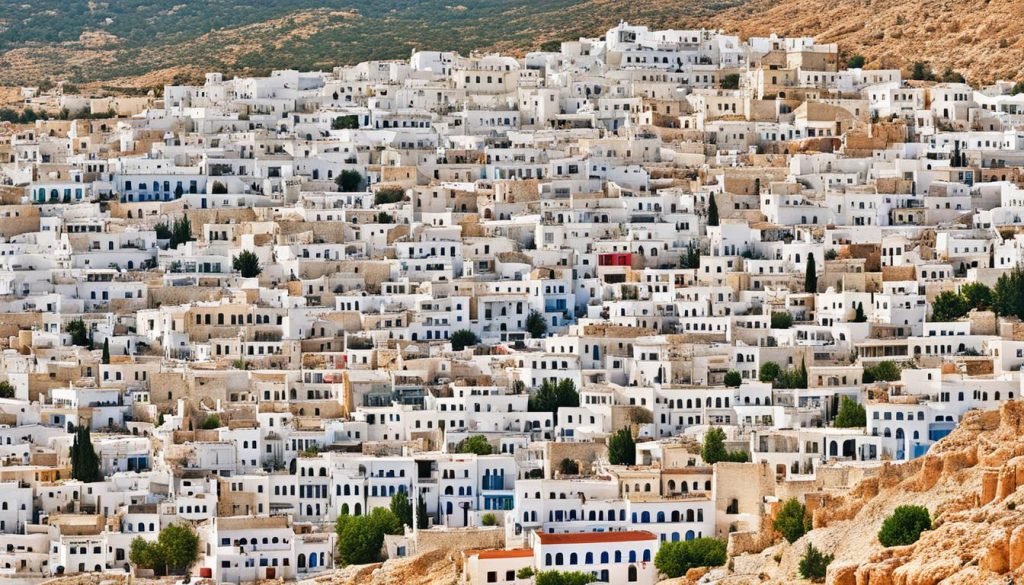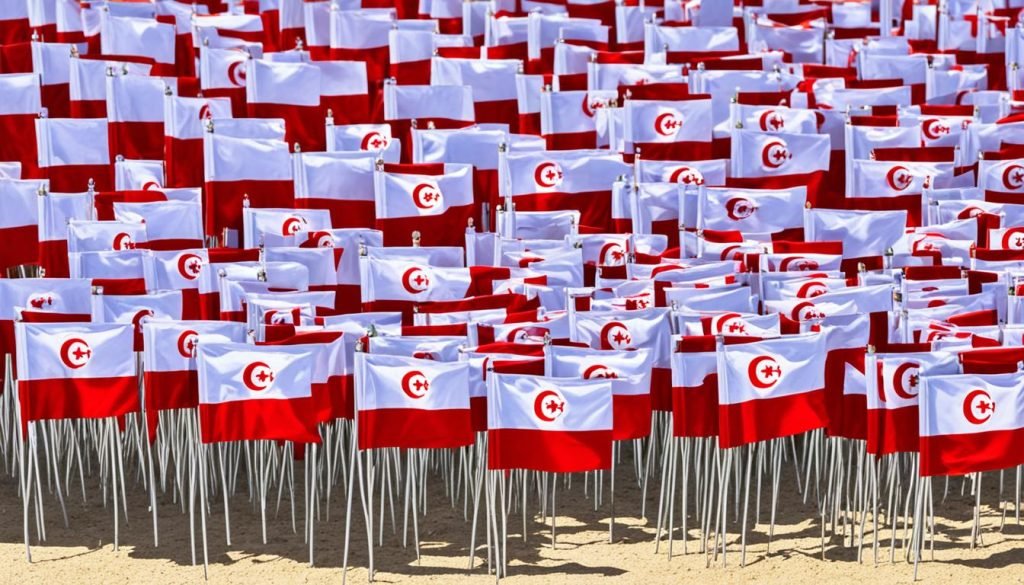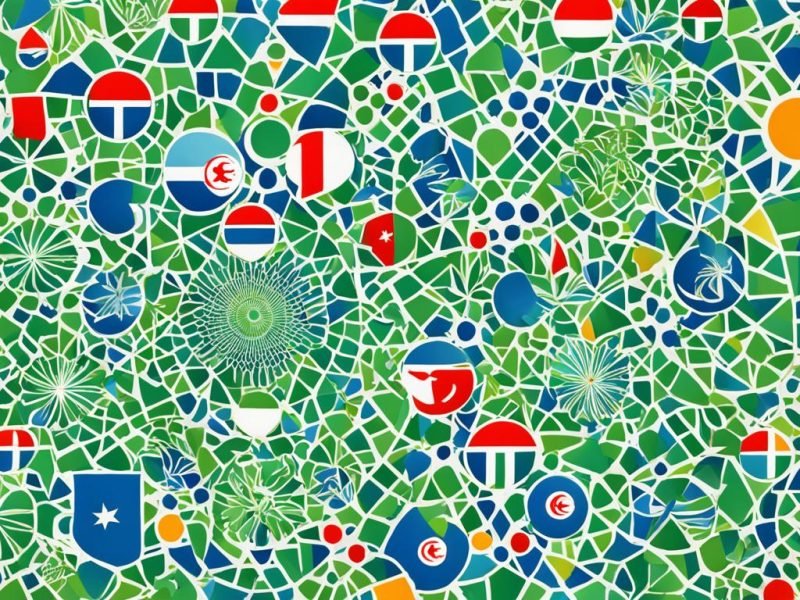Wondering how many people live in Tunisia? By May 14, 2024, the population is expected to hit 12,550,587. This info comes from Worldometer and uses the latest United Nations data. It shows Tunisia’s place in the world’s population rankings.
With these numbers, Tunisia ranks as the 79th most populous country globally. It shows that 0.15% of people worldwide live in this North African country. This fact highlights Tunisia’s significance on the global stage.
The census in Tunisia gives us insight into the residents’ ages. The median age there is 32.3 years, pointing to a population full of youth and potential. This age factor is important for the country’s future in areas like the economy, policies, and social life.
Key Takeaways
- Tunisia’s population, as projected for 2024, stands at 12,550,587 individuals.
- In global population rankings, Tunisia comes in at 79th place.
- The nation accounts for about 0.15% of the entire world population.
- The median age of Tunisia’s citizens is 32.3 years, reflecting a generally youthful demographic.
- Understanding Tunisia’s demographics is crucial for insights into the country’s economic and social structures.
Overview of Tunisia’s Population
Get a clear view of Tunisia’s population dynamics. It’s crucial to understand the population statistics and trends. These factors shape the nation.
Current Population Statistics
About 12,458,223 people live in Tunisia as of 2023. Most people, about 69.3%, live in cities. This shows a high urbanization rate. The population density is 80 people per square kilometer. Tunisia’s median age is a young 32.3 years. This points to a lively demographic.
Historical Population Growth
Over the years, Tunisia’s population growth has changed a lot. In the mid-20th century, growth was at 2.71%. But recently, it’s slowed to 0.34%. These changes highlight shifts in the socio-economic scene. Fertility rates dropped from more than 6 children per woman in the 1970s to about 2 children in 2024. This shows a big shift in demographics.
Demographics and Urbanization
In 2023, Tunisia’s urban population reached 8,630,933. This increase reflects in the busy streets of Tunis, holding 693,210 people. Other cities like Sfax and Sousse have populations of 277,278 and 164,123. This information is key to understanding Tunisia’s population spread.
The move from country to city life in Tunisia shows a common trend towards urban living. This trend affects the economy and development plans. It calls for new policies and infrastructure.

Knowing these aspects is important. They help us understand the big economic forces and social changes. These influences shape Tunisia’s population now and in the future.
Tunisia’s Population in the Global Context
Looking at Tunisia in the world’s population paints a picture of its place. By focusing on Tunisia global rank by population and Tunisia population comparison, we see Tunisia’s spot on the global demographic map. This North African country shows its unique position in world numbers.

Comparison with Global Population Trends
World population numbers are climbing and might top 9 billion by 2050. Tunisia, however, contributes just 0.15% to this massive number. Analyzing Tunisia demographics alongside global population trends highlights its small but noteworthy global footprint.
Tunisia’s Rank Among Countries by Population
Tunisia ranks 79th globally in population size. This places it among countries with medium population levels. It’s neither too crowded nor too empty. This balance in the world scene shows more than just numbers. It reveals the socio-economic effects of Tunisia’s position. Understanding Tunisia’s global rank by population gives a clear Tunisia population comparison with the world.
Factors Influencing Population Change in Tunisia
Looking into what affects Tunisia’s population helps us understand its history and future. We explore how migration, births, deaths, and government actions change the population.
Migration Patterns Affecting Population Size
Migration is key to Tunisia’s population changes. Lately, more people have left than arrived, leading to a drop in population. This affects Tunisia’s economy and society.
Birth and Death Rates: Their Role in Population Dynamics
Birth and death rates are crucial for understanding Tunisia’s population. In 2022, there were about 12.4 births and 6.5 deaths per 1,000 people. This shows the country is growing naturally.
The Impact of Government Policies on Population Growth
The Tunisian government is working to manage population growth. It focuses on health, education, and empowering women. These efforts aim for sustainable development and steady population numbers.
| Year | Birth Rate (per 1,000) | Death Rate (per 1,000) | Net Migration Rate |
|---|---|---|---|
| 2020 | 12.3 | 6.7 | -2.1 |
| 2021 | 12.4 | 6.6 | -2.2 |
| 2022 | 12.4 | 6.5 | -2.5 |
Conclusion
Looking into Tunisia’s population, we see its story through numbers. This country has around 12.5 million people. Although this seems small globally, there’s much to learn from its growth. A key trend is urbanization, with many moving to cities.
This shift highlights how life and work in urban areas are pivotal. They shape what’s next for Tunisia.
To really understand Tunisia, you need to know about its people. The drop in birth rates shows the impact of government policies and individual choices. Also, how Tunisians move, seeking opportunities or facing challenges, tells us a lot.
Indeed, Tunisia’s tale is like many others, dealing with demographic changes. Every number adds to our understanding of its status and global position. These insights not only share the current scene but hint at future directions. Thus, Tunisia’s people add to the vibrant Mediterranean mix.







